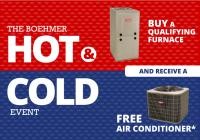 Indoor air quality is probably a term you’ve been hearing a lot lately, particularly if you’re reading this blog post at time of its publishing, near the end of 2020. Air quality is playing a huge role in how safe individuals feel in regards to the transmission of germs and illness. It’s understandable to have this concern, but what many homeowners don’t realize is they may have been suffering from poor indoor air quality for years without knowing it!
Indoor air quality is probably a term you’ve been hearing a lot lately, particularly if you’re reading this blog post at time of its publishing, near the end of 2020. Air quality is playing a huge role in how safe individuals feel in regards to the transmission of germs and illness. It’s understandable to have this concern, but what many homeowners don’t realize is they may have been suffering from poor indoor air quality for years without knowing it!
“Wait,” you may say, “My HVAC systems work just fine and keep me comfortable, so my indoor air quality is fine.”
Okay, but is “fine” really good enough for you? What would “good” indoor air quality mean for your home? When we talk about indoor air quality, we’re going far beyond how hot or cold it is in your home. We’re looking at how healthy the air you breathe is, as well as how that air quality can affect various components of your property. Read on as we explore what good indoor air quality looks like:
Air with the Proper Humidity Balance
The ideal relative humidity level in any home is between 30-50%. Anything below this range is too dry, and above it is too humid.
Why does this matter?
Dry air makes it easier for you and other household members to pass illnesses to each other, first of all. It lowers your body’s natural immunity by drying out your sinuses and mucous membranes, making it easier for germs to reach you. Dry air can also cause painful static electricity, splitting wood furnishings (and instruments) and an overall uncomfortable feeling when you’re at home.
Excessively humid air makes it harder for you to sweat and naturally cool off. It also encourages the development of mold and mildew within your living space. These particles can make even the healthiest person ill, but is particularly harmful to those who already have asthma or allergies.
Purified Air
Do you have a whole-home air purifier in place? These systems help filter out particles like dust, pollen, smoke, VOC’s (volatile organic compounds) and depending on the type of air purifier you have, even mold spores and mildew. There are a number of air purifier types, with some homeowners opting for an electronic air purifier that pulls dust and other particles from the air and others going with a UV air purifier. The UV air purifier is installed directly into the ductwork where it attacks microorganisms like bacteria, mold, and mildew. It does this before these particles even have a chance to enter your indoor air, making it healthier to breathe as a result.
Air purifiers, humidifiers, and dehumidifiers are not the only way to achieve good indoor air quality, and you may find you need some combination of 2 or more of these systems. But this is a good place to start. We guarantee if you start looking into your indoor air quality options with the help of a professional from our team, you’ll discover how to make your home an even better place to be.
Reach out to Boehmer Heating & Cooling today for professional indoor air quality in Pittsburgh, PA!


